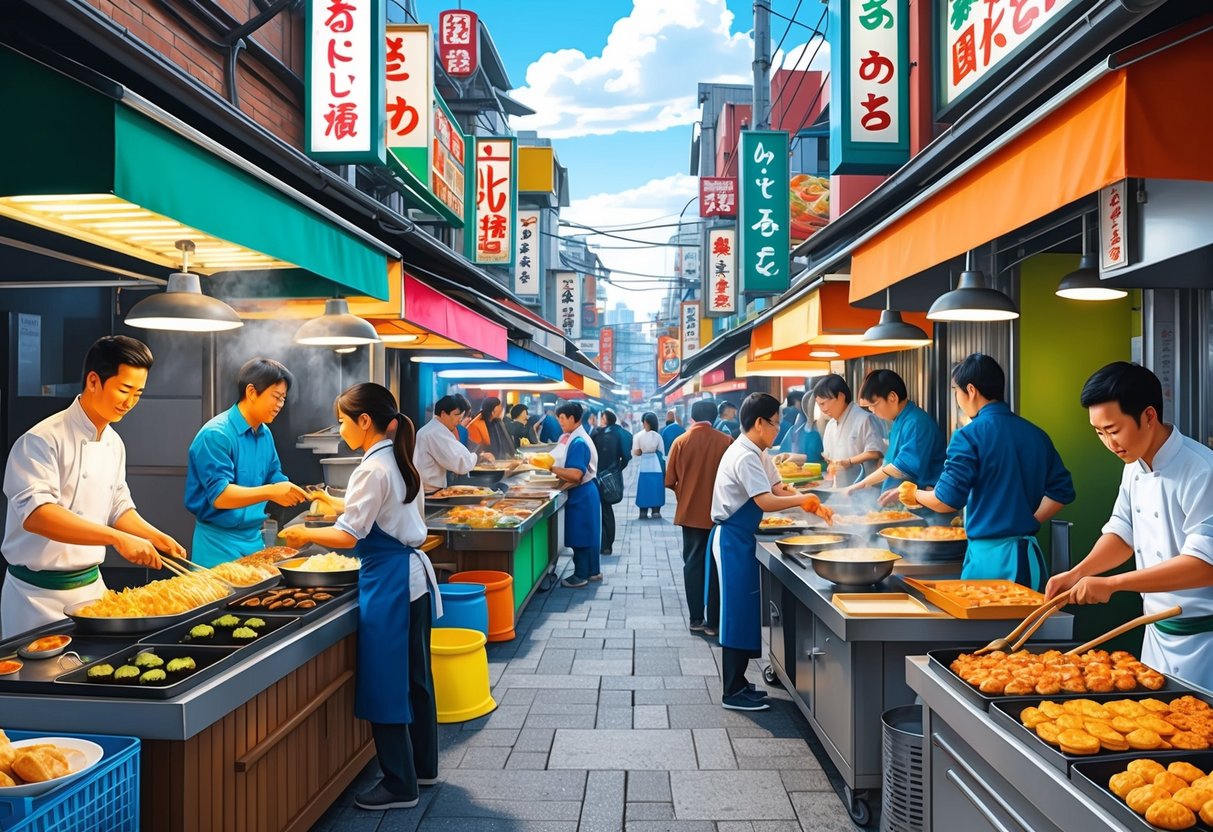
Sushi, Sashimi, and Seafood on the Go
Sushi and sashimi are top highlights of Japanese street food culture, offering fresh flavors and quick bites for visitors. Portable seafood options make it easy to enjoy authentic dishes while walking through bustling markets or exploring local neighborhoods.
Sushi Rolls for Street Food Lovers
Street vendors and casual stalls often serve hand-rolled maki sushi, featuring tightly wrapped rice, seaweed, and a variety of fillings such as tuna, cucumber, or pickled radish. Unlike sushi restaurants, these rolls emphasize convenience and speed without sacrificing traditional taste.
Temaki, or hand rolls, have a cone shape that makes them ideal for eating on the move. Many vendors offer soy sauce, wasabi, and pickled ginger on the side, allowing for quick customization.
Common fillings include salmon, shrimp tempura, crab stick, and even vegetarian options. The rice is seasoned with rice vinegar and a hint of sugar, giving each bite a familiar tanginess found in classic Japanese food.
Prices are affordable, and customers can often watch as the sushi is made before their eyes. For a list of sushi varieties, visit this guide to different types of sushi.
Sashimi Snacks at Street Markets
Fresh sashimi is a staple in Japanese street markets, particularly in famous places like Tsukiji Market in Tokyo. Sashimi consists of sliced raw fish or seafood served without rice.
Typical options include tuna (maguro), salmon (sake), yellowtail (hamachi), and octopus (tako). Vendors often display the seafood on ice, preparing slices on demand for freshness.
Customers enjoy sashimi with a small container of soy sauce, wasabi, and sometimes grated daikon. The simplicity highlights the high quality and natural flavors of the fish.
Adventurous eaters might find unique items like geoduck clam sashimi or other local seafood specialties. For visual inspiration and street food experiences, explore street vendors serving seafood sashimi at Japanese markets such as those featured in this Japanese street food video.
Japanese Street Food in Major Cities

Japanese street food is a prominent part of urban life, drawing both locals and tourists to explore unique culinary destinations. Each city and neighborhood offers iconic snacks, flavors, and local specialties, often found in bustling markets or by historic temples.
Tokyo: Shin-Okubo and Asakusa
Tokyo stands out as one of Japan’s top destinations for diverse street food. The Shin-Okubo district, known for its vibrant Korean community, features fusion snacks like savory hotteok pancakes and Korean fried chicken, alongside traditional Japanese entries such as takoyaki and yakitori.
Asakusa, a historic district in Tokyo, is famed for its proximity to Senso-ji Temple and rows of bustling food stalls. Here, visitors savor ningyo-yaki (small sponge cakes filled with red bean paste) and crispy senbei rice crackers, both of which are popular souvenirs.
The area also boasts menchi katsu (deep-fried meat patties) and freshly made melonpan—a sweet, melon-shaped bread that’s crisp on the outside and soft inside. For a detailed guide to Tokyo’s most popular street food dishes—including takoyaki, yakitori, and menchi katsu—visit this Tokyo street food article.
Kyoto’s Night Markets
Kyoto, once Japan’s ancient capital, continues to charm with its night markets offering a more traditional take on Japanese street cuisine. Nishiki Market is among the most famous culinary destinations, where food stalls serve up local specialties like yatsuhashi (cinnamon rice crackers), kuzu mochi (sweet rice cakes), and assorted skewered seafood.
Night markets in Kyoto create a lively atmosphere, with lantern-lit paths and scents of grilled delicacies wafting through the air. Seasonal produce and handmade treats are plentiful.
Many visitors seek matcha-flavored desserts or pick up handcrafted sweets as souvenirs. Prices tend to be modest, making it accessible for street food enthusiasts and families alike.
Exploring Senso-ji Temple Stalls
The area around Senso-ji, Tokyo’s oldest temple, is lined with food stalls that epitomize traditional Japanese street flavors. Nakamise Dori, the shopping street leading to Senso-ji, offers an array of quick bites such as agemanju (deep-fried sweet bread), kaminari-okoshi (puffed rice snacks), and fresh taiyaki shaped like fish with sweet fillings.
Street vendors in this area prioritize both taste and presentation. Many dishes are designed to be eaten by hand while walking, making them ideal for travelers.
This spot is also ideal for souvenir shopping—many stalls sell beautifully packaged snacks alongside their ready-to-eat specialties. For more on the tastes found near Senso-ji, see this guide to Japanese street food in every corner.
Authentic Ingredients and Cooking Techniques

Japanese street food relies on fresh ingredients, precise preparation methods, and elements that strike a balance between sweet, savory, and umami flavors. Distinctive sauces, careful cooking styles, and varied protein sources, including plant-based options, shape the signatures of this cuisine.
Traditional Sauces and Condiments
Essential Japanese condiments like soy sauce, mirin, and rice vinegar provide much of the depth in street food flavor profiles. Soy sauce delivers umami and saltiness, and is used as a marinade, dipping sauce, or finishing touch on numerous dishes.
Miso is another building block, lending a salty-sweet flavor to soups, glazes, and marinades. It is especially prominent in dishes like miso soup, which is sometimes served as part of a Japanese meal alongside popular street foods.
Additional key condiments include Kewpie mayonnaise, sweet-savory okonomiyaki sauce, and spicy karashi mustard. These flavors complement fillings for okonomiyaki, takoyaki, and yakisoba, among others.
Using authentic condiments is crucial for recreating true Japanese street food at home. For an overview of essential street food flavorings and ingredients, see this guide to must-try Japanese foods.
Teppanyaki and Izakaya Cooking Styles
Many street foods draw inspiration from the vibrant food scenes found at izakaya (Japanese pubs) or are cooked teppanyaki-style on a hot iron griddle. Teppanyaki, which literally means “grilling on an iron plate,” is used to prepare dishes such as okonomiyaki (savory pancakes) and yakisoba (fried noodles), where ingredients are seared quickly to preserve texture and flavor.
In izakaya cooking, small bites and shared dishes are common. Skewered items like yakitori, grilled seafood, and gyoza often feature.
Chefs use high heat and minimal oil, letting the freshness of ingredients shine through. Seasoning remains light, focusing on enhancing primary flavors rather than masking them.
Traditional techniques prioritize careful knife work and presentation. Teppanyaki and izakaya methods emphasize lively presentation and dining interaction, making them favorites both at home and at Japanese street food stalls.
Tofu and Plant-Based Options
Plant-based proteins, particularly tofu and natto, have long been part of Japanese street and home cooking. Tofu is made from pressed soybeans and is known for its mild flavor and ability to absorb surrounding seasonings.
It’s frequently grilled, fried, or added to miso soups. Natto is fermented soybean with a pungent aroma and sticky texture, served as a protein-rich topping or side in many casual meals.
Modern street stalls now offer more vegan and vegetarian options, incorporating tofu and other soy-based products to appeal to changing dietary preferences. Common plant-based dishes include agedashi tofu (deep-fried tofu in a savory dashi broth) and yaki onigiri (grilled rice balls).
These showcase the adaptability of Japanese cuisine, fitting seamlessly alongside flavor-packed meats and seafood in a traditional Japanese meal.



